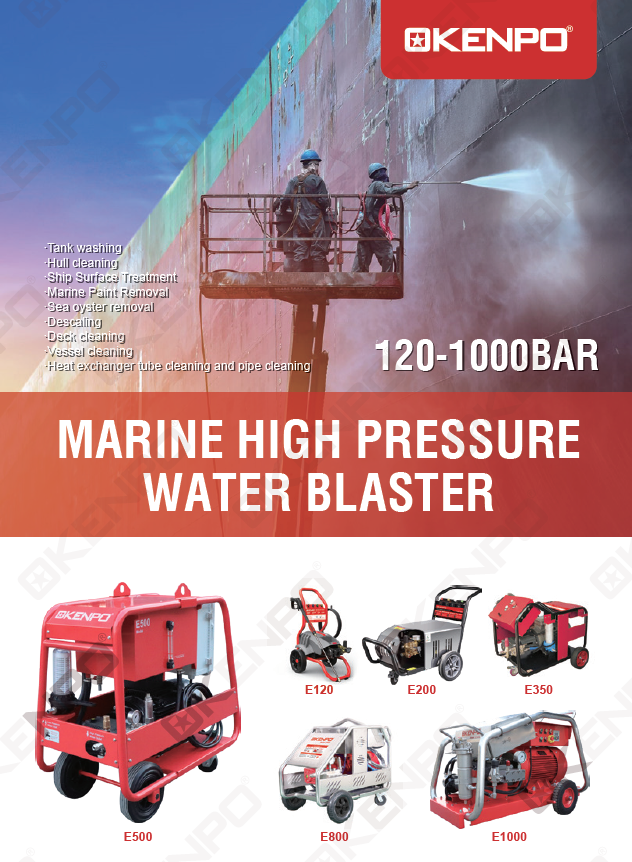High-pressure water blasters, like the KENPO-E500, are robust tools engineered for effective cleaning across a range of applications, from industrial environments to marine settings. Although these machines provide considerable advantages, their use entails certain risks. It is crucial to prioritize safety and proper operation. This article offers detailed safety measures and operational guidelines to assist users in optimizing the performance of high-pressure water blasters while reducing potential dangers.
Understanding the Risks
High-pressure cleaning devices function by ejecting water at extremely high speeds, capable of cutting through dirt, grease, and even paint. However, the same force that effectively cleans surfaces can also inflict serious injuries. Users must handle these machines with the respect they warrant, similar to operating a high-speed cutting tool.
Click the link to watch the video: KENPO Marine High Pressure Water Blasters
Key Safety Guidelines
1. Age Restrictions:
Only trained and authorized individuals should operate high-pressure water blasters. Anyone below the age of 18 is strictly forbidden from using the machine. This age limitation ensures that operators possess the maturity and comprehension necessary to safely manage such powerful equipment.
2. Electrical Safety:
Always utilize a suitable plug and socket that is equipped with grounding to earth wiring. Connecting to a system that lacks this grounding may result in electrical shock. It is recommended to have a certified electrician carry out the installation. Additionally, incorporating a Residual Current Device (RCD) or Ground Fault Circuit Interrupter (GFCI) into the electrical supply configuration provides an extra layer of safety.
3. Regular Maintenance Checks:
Maintaining the machine and its accessories in optimal working order is essential. Regularly examine the water blaster for any defects, with particular attention to the insulation of the electric cable. If any issues are found, refrain from operating the machine. Instead, have it serviced by a qualified technician.
4. Personal Protective Equipment (PPE):
It is essential to wear the appropriate PPE. Operators must use eye protection to guard against debris that may repel or ricochet. Furthermore, suitable clothing and non-slip footwear are necessary to safeguard the operator from possible injuries. It is important to refrain from attempting to clean clothing or footwear using the machine itself.
5. Bystander Safety:
Bystanders should be kept at a safe distance from the work area. The high-pressure jets can inflict serious injuries, making it vital to maintain a clear zone around the operational site.
6. Avoid Dangerous Practices:
Never aim the spray at yourself, others, or live animals. These machines can produce powerful jets that can cause severe harm. Additionally, avoid spraying electrical equipment or the machine itself, as this creates a significant electrical hazard.
7. Safe Operating Procedures:
Always ensure that the machine is turned off and disconnected from the power supply during servicing or repairs. This practice helps prevent accidental activation, which could result in injuries.
8. Trigger Management:
The trigger should never be taped, tied, or altered to remain in the “on” position. If the lance is dropped, it may whip around dangerously, potentially leading to serious injuries.
9. Proper Handling of the Spray Lance:
Always grip the spray lance with both hands to control the recoil when activating the trigger. A lance length of at least 1.0 meter is advised to minimize the risk of pointing it at oneself.
10. Hose Management:
When laying out hoses, handle them carefully. Ensure that each hose is labeled with the manufacturer’s symbol, a serial number, and the maximum operating pressure. Regularly inspect all hoses and fittings for defects before each use, replacing any that exhibit signs of wear.
Safe Application Guidelines
To ensure the safe operation of the KENPO-E500, it is crucial to adhere to proper procedures. Below are additional guidelines to promote safe application:
1. Comprehensive PPE Use:
In addition to eye protection, operators must don a full face shield, hearing protection, and a hard hat. Certified jackets, trousers, and boots that are designed to withstand high-pressure jets offer further protection against injuries.
2. Maintain a Safe Working Environment:
Always operate the machine in a designated area that is free from unnecessary personnel. Create a specific zone where only trained operators are allowed to enter.
3. Training and Instructions:
Only personnel who have received proper instruction should be permitted to operate the machine. Adequate training ensures that users comprehend the equipment’s functionality and the associated risks.
4. Daily Equipment Checks:
Prior to each use, operators should perform a comprehensive inspection of the machine, including hoses and fittings. Any defective components must be replaced immediately to avert accidents during operation.
5. Emergency Procedures:
Operators should be well-acquainted with emergency shutdown procedures and ensure that all personnel know how to react in the event of an accident.
6. Communication:
Establish clear communication protocols among team members. Utilize hand signals or radios to maintain communication while operating the machine, particularly in noisy environments.
7. Environmental Considerations:
Be conscious of the environment when utilizing high-pressure water blasters. Avoid directing spray toward sensitive areas, such as soil or water bodies, to prevent contamination. Whenever feasible, use biodegradable cleaning agents to minimize environmental impact.
8. Post-Operation Care:
After use, clean the machine and store it appropriately in a designated area. Ensure that all accessories are accounted for and in good condition. Proper maintenance and storage extend the life of the equipment and ensure safety for future use.
Conclusion
High-pressure water blasters, such as the KENPO-E500, provide exceptional cleaning efficiency across a range of applications. Nevertheless, this power entails considerable responsibility. By following stringent safety protocols and operational procedures, users can reduce risks and maintain a secure working environment. Investing in adequate training, regular maintenance, and protective gear not only improves safety but also optimizes the effectiveness of high-pressure cleaning tasks. Always keep in mind: prioritize safety, and efficiency will naturally ensue.
Post time: Aug-04-2025







